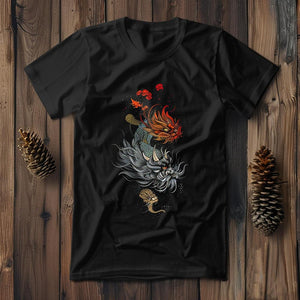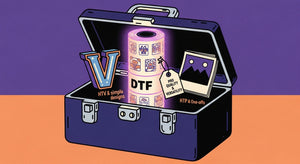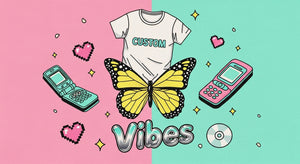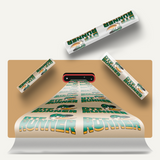Table of Contents
- What Are Gang Sheets?
- Advantages of Utilizing Gang Sheets for DTF Transfers
- Gang Sheeting (Design & Preparation)
- Trimming the Designs on the Gang Sheet
- Preparing the Garment for Transfer
- Weed and Place the DTF Transfer onto Clothing
- Preparing the Heat Press
- Applying the DTF Transfer
- Aftercare and Withdrawing Process
- Gang Sheet Best Practices
- DTF Transfer Gang Sheet Application
Direct-to-film (DTF) transfers represents a groundbreaking technology in the custom apparel industry, providing vivid and lasting prints on an extensive range of materials. Although combined with gang sheets, it can make the process more efficient and save a lot of money. Gang Sheets- you can gang up several designs on to a single sheet, minimizing print waste and optimizing the process. In this complete guide, we will teach you exactly how to apply DTF transfers from gang sheets step-by-step, and never miss a beat again.
What Are Gang Sheets?
In the next sections we are going to also see what exactly gang sheets are, and why they play such an important role in dtf printing before getting into the application process. Gang sheets are those big sheets, where we put many designs in a smart way to cover the most space possible. The method is best suited to the companies which are dealing with large numbers of orders like repeatable small intricate designs. This is when gang sheets come into play and become a powerful authority in DTF printing as all designs get printed on one sheet, saving materials and production time!

Advantages of Utilizing Gang Sheets for DTF Transfers
Benefits
Given the various benefits, many printing professionals prefer using gang sheets for DTF transfers.
The most important advantage in the use of gang sheets is cost efficiency. You can reduce your overall production costs simply by filling more designs into the same sheet, and hence saving film with less ink to be used. This is especially helpful for businesses taking large orders or offering volume discounts.
Efficient utilization of material
Gang sheets enable you to use your sheet as efficiently as possible, letting you organize your designs perfectly, making sure that the empty pixels are less I mean waste is minimized. Cost: It will be expensive and this also leads to the wastage of material that is not being used otherwise which could have been thrown off.
Save on Time
While printing individual transfers takes a long time, you can print up to eight different designs together using gang sheets. This feature truly shines when we are in a high-volume production environment where, well, you know what they say about time.
Quality
Gang sheets provide a reliable way to produce this image identical for all transfers since the conditions surrounding that transfer are the same each time. This insures you keep the level of quality your brand has to offer and deliver a polished product to customers.
Gang Sheet & Color Variety
Gang sheets are perfect for simple logos and multi-color images alike. Which is great for print shops that offer a variety of custom apparel products.
Gang Sheeting (Design & Preparation)
They start much earlier, long before we ever apply DTF transfers from gang sheets in the transfer process. This is the process in which the gang sheet is designed and prepared itself. I put this step in because depending on how you choose to lay out your designs on the sheet can affect not only ease of application but it also will help save some time during production.
With regards to design
When you are laying out your gang sheet keep in mind the size and room required for each design. Gang designs to maximize the ease at which they can be cut and applied by layout. For instance, if the space between patterns you placed is too large, it means that a lot of usable material may be thrown away, or if the spaces are very near — depressing also that your sticker design cannot be cut out.
Software Tools
Use design software that works with gang sheets. Most professional print apps include features that enable you to organize all your designs on a single sheet, which is more efficient and saves paper space.
If you use some colours in a single design, try to maintain presence of all the colours across all designs. DTF printing is a relatively complex process and the color must be meticulously managed, in order for the final output to match what was desired. Completely the colors profiles with your DTF printer and inks.
Gang Sheet Printing
After your designs are placed, print the gang sheet with a DTF printer that is of good quality. However, be sure that you are using the right film or ink based on your printer model for better output.
Trimming the Designs on the Gang Sheet
After you have printed your design, the next thing is cut the individual designs out of the gang sheet. This an intricate process which includes preparing each pattern meticulously for them to pass onto a surface of the fabric.
Material
Sharp pair of scissors or precise cutting tool to cut out the designs. A blade machine, for example a vinyl cutter, is suitable for more intricate and high volume design.
Cut Technique
When cutting make sure leave some space around the print so it will be easy to handle when you transfer_WRONLY This offset also enables to make the design so that cutting can take place without designing being harmed or malformed from its edges.
Sorting the Designs
After cutting, sort the designs in sequence (left side first). & This will make it easier to transfer and less likely that mistakes are made.
Preparing the Garment for Transfer
You have your designs cut out and prepped, but before you transfer the design onto to the garment. To make sure your transfer adheres correctly and washes well, proper prep is key.
Washing the Garment
The garment to be imprinted must be washed well and free of dirt, oils or any other contaminant that might prevent the transfer from taking. Wash the fabric as needed, and allow it to dry completely if you do.
Stage iron
Iron the clothing to dispose or any wrinkles or creases. To release the transfer paper evenly a flat is surface are required.
Resting The Garment
Put the garment on the heat press platen, position it in a straight and centralized manner. If you need something extra to assist with this use a ruler or a positioning guide.
Weed and Place the DTF Transfer onto Clothing
Now that the garment is ready, all you have to do is put a DTF transfer on it. The design on the Mylar is what will be transferred to your garment, so be a bit meticulous when you lay it down.
Placing the design
Place this cut-out DTF transfer on the garment as mentioned in original design. Center and straighten it up.
Sealing the Transfer
Sealing is necessary, then transfer can be kept there with heat resistant tape if needed. This stops it from moving as you transfer to keep its exact placement.
Check Placement
Make sure the design is in the correct position. It is far easier to move the placement now than after it has been applied.
Preparing the Heat Press
With the garment and transfer properly arranged, you are ready to set up your heat press. It is extremely important to have the right setting to allow the transfer to stick and last.

Temperature
The standard temperature range for DTF transfers is around 300°F – 325°F (150°C-160°C) most of the time. Although, always refer to the exact temperature adjustments recommended on your DTF transfer.
Pressure
You should set it up to medium with firm pressure. The proper pressure is crucial for making sure a transfer has been applied evenly throughout the whole design.
Heat Press Time
Normally need to press DTF transfers for around 10 to 15 seconds. Refer to your transfer packaging for specific timing.
Pre-Press
Press garment for a couple of seconds before applying transfer. This will vacuuming out any last remnants of moisture and clear the way for a seamless transfer.
Applying the DTF Transfer
After that, prepare your heat press. Great attention must be given to this step because otherwise no one is successful, so it needs to be done with great care.
Lowering the Heat Press
Put the garment with the transfer down below the heat press and bring down the top plate. Check that the whole layout is protected by the plate.
Applying the Transfer
Follow recommended pressure and time instructions. Wait for the time to elapse before peeling back the press, so that your transfer sticks properly.
Peel Off carrier sheet
After you have pressed your design, lift up the heat press while still warm and peel away the carrier sheet. Unpeel the image at a steady, slow rate Otherwise it could damage your image.
Aftercare and Withdrawing Process
After the transfer
you need to check it like a pro, make sure all is there and treat your garment in the right way
Check the Transfer
Examine the garment to ensure there are no areas where the transfer may not have properly adhered. To do this, re-press those places, if needed.
You also need to educate your customers on how to care for the garment as well. Wash garments inside out in cold water with no harsh detergents or bleach.
Gang Sheet Best Practices
Here are a few pro tips to optimise your gang sheets:
Design Efficiently
Consider how your designs will be cut and/or separated when designing the gang sheets. More on this in later blog posts)Good design optimizes, and makes efficient use of time (and other resources), which in turns saves on materials.
Just like everything
Practice on scrap when you are new to gang sheets, before the real thing. What is the use – This will enables you to adapt your method and get better results.
Quality Materials Go a Long Way
Purchasing high-quality DTF films and inks is key to getting the most out of your transfers, ensuring their longevity. Cheap materials lead to shit results, so use a little bit more monnaayy!
DTF Transfer Gang Sheet Application
DTF transfers transferred from a gang sheet is a fast and cost-effective way to make top-notch, custom garments. The following two steps ensure good quality process control, and consistent results, with which the final stitching will please a customer by giving him value for money for their garment/s — in both smallest numbers and under large volumes. Four gang sheets should be the easier way to go about it, and done in ways that you will get what you want. All you need to do is incorporate this method into your routine and voilà: increased efficiency, lower costs, satisfied customers. I hope this post found you well. Happy Printing!






